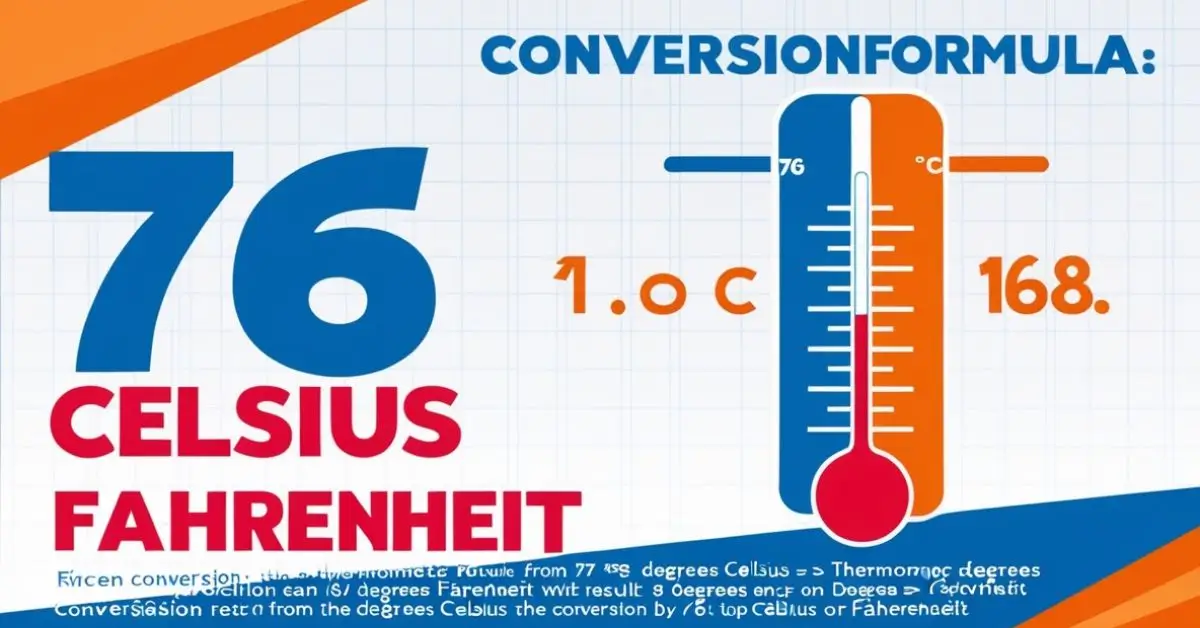If you’re wondering what 76 Celsius to Fahrenheit is, you’re in the right place. Converting temperatures between Celsius and Fahrenheit is a common necessity in everyday life. Whether you’re traveling to a country that uses Fahrenheit or need to convert temperature data for scientific purposes, understanding the conversion process is essential. In this article, we will explore the conversion of 76 Celsius to Fahrenheit, how to do it, and why the Celsius and Fahrenheit scales differ.
By the end of this article, you will understand the simple formula behind the conversion and learn a few fun facts about both temperature scales.
What is the Conversion from 76 Celsius to Fahrenheit?
To convert 76 Celsius to Fahrenheit, we need to use the standard formula:
Fahrenheit (°F) = Celsius (°C) × 9/5 + 32
Let’s apply this formula step by step to convert 76°C into Fahrenheit:
- Multiply 76 by 9/5:
76 × 9/5 = 136.8 - Add 32 to the result:
136.8 + 32 = 168.8
So, 76°C is equal to 168.8°F.
This simple conversion can be done for any temperature in Celsius. Understanding this conversion helps bridge the gap between the two most common temperature systems used worldwide.
Celsius vs. Fahrenheit: A Brief Overview
Before we dive deeper into the conversion process, it’s important to understand the difference between the Celsius and Fahrenheit scales. The Celsius scale (also known as centigrade) is primarily used worldwide, with the exception of a few countries like the United States, which uses the Fahrenheit scale.
Celsius Scale
- The Celsius scale is based on the freezing and boiling points of water, which are set at 0°C and 100°C respectively.
- This scale is metric-based, which makes it easier for scientists and engineers to use.
Fahrenheit Scale
- The Fahrenheit scale has the freezing point of water set at 32°F and the boiling point at 212°F.
- It is still widely used in the United States, especially in weather forecasting, cooking, and household thermometers.
Why Different Scales?
The Celsius scale is often seen as more logical for scientific and everyday purposes because it’s based on the properties of water. On the other hand, Fahrenheit, which originated from a different set of physical phenomena, remains ingrained in the daily lives of certain countries.
How Accurate is the 76 Celsius to Fahrenheit Conversion?
Converting temperatures accurately is critical, especially in scientific and technical applications. The conversion of 76°C to Fahrenheit is precise, giving us an answer of 168.8°F. When using the formula, it’s important to ensure you follow each step carefully. A slight mistake in calculation can lead to a significant error, especially when dealing with extreme temperatures.
Moreover, there are many cases in which understanding these conversions is more than just theoretical. For example, cooking in a Fahrenheit-based oven might require converting Celsius-based recipes. Similarly, travelers might need to understand temperature differences when going to a country that uses Fahrenheit.
The Significance of 76 Celsius to Fahrenheit in Real-Life Applications
Understanding the conversion of 76 Celsius to Fahrenheit can have practical implications. For example, temperatures around 76°C are quite high and might be encountered in certain industrial processes or scientific experiments. In real-world contexts:
- Boiling Water: The boiling point of water is close to 100°C, so a temperature of 76°C is just below boiling. It’s hot enough to scald, so it’s important to handle materials at this temperature carefully.
- Weather and Climate Studies: In some regions where temperatures may exceed 76°C in industrial environments, temperature conversions are crucial for effective climate monitoring, especially in countries using the Fahrenheit scale.
- Human Comfort and Safety: In terms of human comfort, temperatures in the 70s°F are generally considered warm but not unbearably hot. This comparison helps people adapt to different climates depending on which scale is in use.
Practical Uses of the Celsius to Fahrenheit Conversion
The 76 Celsius to Fahrenheit conversion is often used in various industries and professions. Let’s take a look at a few examples:
- Meteorology: Weather forecasts use Fahrenheit or Celsius depending on the location. For instance, knowing how to convert Celsius to Fahrenheit ensures people in the United States can easily interpret weather forecasts from countries that use Celsius.
- Cooking: Many recipes worldwide are measured in Celsius, especially in Europe and other parts of the world. A recipe might state that the oven should be preheated to 180°C, but a cook in the U.S. would need to convert it to Fahrenheit (356°F). Knowing the conversion formula can save time.
- Science and Engineering: The Celsius scale is used extensively in scientific research. Engineers working with thermodynamics, meteorologists, and biologists often work with the Celsius scale to measure temperatures in experiments.
Celsius to Fahrenheit Conversion Chart
Here’s a quick chart to give you an overview of common temperature conversions between Celsius and Fahrenheit:
| Celsius (°C) | Fahrenheit (°F) |
|---|---|
| 0 | 32 |
| 25 | 77 |
| 50 | 122 |
| 76 | 168.8 |
| 100 | 212 |
| 200 | 392 |
This chart helps provide quick reference points when comparing temperatures in Celsius to their Fahrenheit equivalents.
The Importance of Temperature Scales in Different Fields
While the conversion of 76 Celsius to Fahrenheit is straightforward, it’s important to understand why temperature scales matter across various fields:
- Health and Safety: In industries like food processing or pharmaceuticals, accurate temperature measurements are vital for maintaining safety and quality standards.
- Industrial Use: Many machines, furnaces, or engines operate at high temperatures, and knowing the exact temperature in Fahrenheit or Celsius can help prevent accidents or damage.
- Climate and Weather Forecasting: Understanding temperature variations helps meteorologists predict weather patterns and keep the public informed about extreme conditions.
Conclusion:
76 Celsius to Fahrenheit is a relatively simple conversion, equaling 168.8°F. Whether you’re a scientist, traveler, or someone working in a field where temperature measurements are critical, knowing how to convert between Celsius and Fahrenheit is a useful skill.
As we’ve explored, temperature conversions play a role in various fields, from cooking and weather forecasting to industrial safety and scientific research. Remember, the formula for converting Celsius to Fahrenheit is:
Fahrenheit = (Celsius × 9/5) + 32
Using this formula, you can convert any temperature between these two scales effortlessly. Always ensure that you apply the formula accurately for precise measurements in practical applications.
FAQs
What is 76 Celsius in Fahrenheit?
76 Celsius is equal to 168.8 Fahrenheit.
Why do we need two temperature scales?
Celsius is widely used in scientific contexts, while Fahrenheit is still commonly used in countries like the U.S. for weather, cooking, and household temperature measurements.
How do I convert Celsius to Fahrenheit?
Use the formula: Fahrenheit = (Celsius × 9/5) + 32.
Is 76 Celsius considered hot?
Yes, 76°C is a very hot temperature, close to boiling point, and can cause burns.
What is the freezing point of water in Fahrenheit?
The freezing point of water is 32°F in the Fahrenheit scale.
Can I use the Celsius to Fahrenheit conversion for all temperatures?
Yes, this conversion works for any temperature and is widely used in scientific and practical applications.












